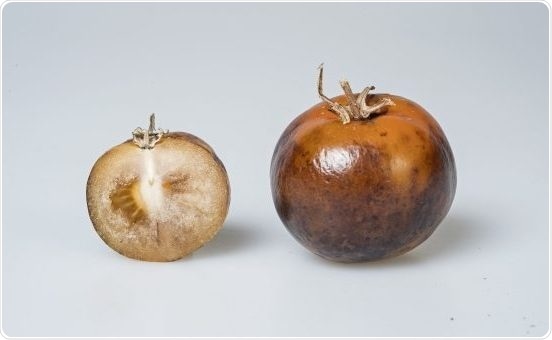L-DOPA is a drug used for treating Parkinson’s disease, and now researchers have created a tomato that is enriched with this drug. This innovation could lead to a new, inexpensive source of one of the most essential medicines in the world.

Tomato fruit enriched in L-DOPA. Image Credit: Phil Robinson.
The production of the genetically modified (GM) tomato holds significant implications for developing nations, where access to pharmaceutical medications is quite limited.
This innovative use of tomato plants as a natural source of L-DOPA can also benefit individuals who suffer the adverse effects—like behavioral complications and nausea—of chemically produced L-DOPA drugs.
Tomato was selected because it is a broadly cultivated crop. It can be used to scale up production and could provide a controlled and standardized natural source of L-DOPA.
The team, headed by the John Innes Center, altered the tomato fruit by adding a gene responsible for producing L-DOPA in beetroot, where it plays a role in the production of pigments, called betalains.
L-DOPA is made from an amino acid, tyrosine¸ present in various foods. The researchers embedded a gene that encodes tyrosinase—an enzyme that utilizes tyrosine to create molecules, like L-DOPA. This increased the concentration of L-DOPA, mainly in the fruit portion of the plant, and resulted in higher yields when compared to those linked to the production of L-DOPA in the entire plant.
The concentrations obtained in the tomato fruit—150 mg of L-DOPA per kilogram of tomatoes—were similar to those seen in other L-DOPA-accumulating plants—without some of the familiar disadvantages that had earlier impeded the metabolic production of the drug by the plant.
The team is aiming to build a production pipeline, in which L-DOPA is obtained from the tomatoes and processed into the pharmaceutical product.
The idea is that you can grow tomatoes with relatively little infrastructure. As GMOs (genetically modified organisms) you could grow them in screen houses, controlled environments with very narrow meshes, so you would not have pollen escape through insects.”
Cathie Martin, Study Corresponding Author and Professor, John Innes Centre
Professor Martin continued, “Then you could scale up at a relatively low cost. A local industry could prepare L-DOPA from tomatoes because it’s soluble and you can do extractions. Then you could make a purified product relatively low tech which could be dispensed locally.”
Parkinson’s disease is a growing problem in developing nations, where several people are unable to afford the daily price of $2 for synthetic L-DOPA.
L-DOPA—an amino acid precursor to the neurochemical dopamine—is used to offset the reduced supply of dopamine in patients with Parkinson’s disease.
L-DOPA, also called Levodopa, has been the standard of treatment for Parkinson’s disease, ever since its establishment as a medication in 1967. The World Health Organization (WHO) has declared L-DOPA as one of the crucial medicines and the market value of this drug runs in hundreds of billions of dollars.
While the most common form of the medication is created through chemical synthesis, natural sources also exist. Reportedly, only a few plants contain quantifiable amounts of the molecule, primarily in seeds.
The velvet bean, Mucuna pruriens, has been extensively studied and its seeds contain up to 10% L-DOPA. However, this presents a problem because the plant is encased in urticating hairs containing mucunian that can cause allergic reactions and irritation in field workers, who harvest the crop. Besides this, the beans themselves contain high levels of tryptamines that can cause hallucinations in patients with Parkinson’s disease.
We have demonstrated that the use of the tyrosinase-expressing tomatoes as a source of L-DOPA is possible. It’s a further demonstration of tomato as a strong option for synthetic biology. Additionally, there were surprising beneficial effects including improvement in shelf-life and raised levels of amino-acids that we can investigate.”
Dr Dario Breitel, Study First Author, John Innes Centre
Source:
Journal reference:
Breitel, D., et al. (2020) Metabolic engineering of tomato fruit enriched in L-DOPA. Metabolic Engineering. doi.org/10.1016/j.ymben.2020.11.011.